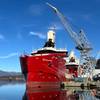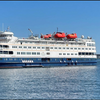Deep-Sea Tremors May Provide Early Warning
Scientists from the Woods Hole Oceanographic Institution (WHOI) and the University of Southern California (USC) report that some types of large undersea earthquakes may be predictable on time scales of hours or less. Earthquakes on land are generally not preceded by systematic immediate foreshocks and hence cannot be predicted as easily with the same methods.
The research team, led by Jeffrey McGuire of WHOI, studied past earthquakes along five transform faults on the East Pacific Rise, where tectonic plates are spreading apart at a rate of more than ten centimeters or five inches a year. The team used data from sensors deployed by the National Oceanic and Atmospheric Administration’s Pacific Marine Environmental Laboratory that pinpointed the time and location of foreshocks and the mainshocks or larger earthquakes.
"This is the first demonstration of good short-term predictability for big earthquakes," study coauthor Thomas Jordan of the USC Southern California Earthquake Center said. "Some scientists believe that earthquakes come on suddenly with no warning signs, and the big ones are therefore unpredictable. In other parts of the oceans, they may be."
The researchers defined a foreshock as any tremor of at least a magnitude 2.5 on the Richter scale, and a mainshock as a tremor of magnitude 5.4 or greater. Using earthquakes that occurred in the last ten years as a test case, they set up a hypothetical “alert” for an hour within a 15-kilometer (about ten-mile) radius of the epicenter of every potential foreshock. This “early-warning system” would have successfully predicted six of the nine major earthquakes that occurred along two of transform faults, Discovery and Gofar, between 1996 and 2001, despite having alerts in a very small percentage of the total time period.
The team’s findings suggest that short-term prediction - the ability to forecast an earthquake in the hours or minutes before it hits - may be feasible under certain circumstances. McGuire says that although mid-ocean ridges and associated transform faults are far from main population centers on land, the fact that a degree of short-term predictability exists in the deep sea should help seismologists better understand the earthquake process in general.
McGuire says a new generation of ocean bottom instrumentation, a major technical challenge, will help scientists improve understanding of the earthquake process. “If both foreshocks and mainshocks are triggered by an earlier event, which could be a gradual slipping along a fault line, technically known as an aseismic slow slip transient that doesn’t create seismic waves, then it could be detected with the right instruments.”
Such slow events can be detected on land at places like the San Andreas Fault, where movement is recorded by an extensive array of sensors. In the deep sea, slow slip transients have been detected in subduction zones, where one tectonic plate is thrust under another. Such events have been detected off Japan and along the Cascadia Fault off the Pacific Northwest. However ,the detected events did not trigger major earthquakes.
The researchers note that subduction zones have higher foreshock rates than continental regions, so the ability to detect foreshocks, even on a short-term basis, has significance in earthquake prediction. Moreover, a slow slip transient was detected 15 minutes before the 1960 Chilean earthquake, at magnitude 9.5 the largest in recorded history.
Most major earthquakes occur along subduction zones, but whether earthquakes on subduction zones can be predicted systematically remains controversial and will require improved seafloor-based observations.
The researchers say that if an extensive array of sensors like that along the San Andreas Fault were placed on the sea floor, seismologists would likely see the earthquake coming. McGuire will lead an expedition in 2007 to deploy sensors along the East Pacific Rise and begin testing that idea.
The study was supported by the Frank and Lisina Hoch Endowed Fund and the Deep Ocean Exploration Institute at WHOI, the National Science Foundation, the Southern California Earthquake Center, and the U.S. Geological Survey.









